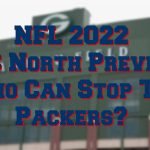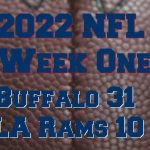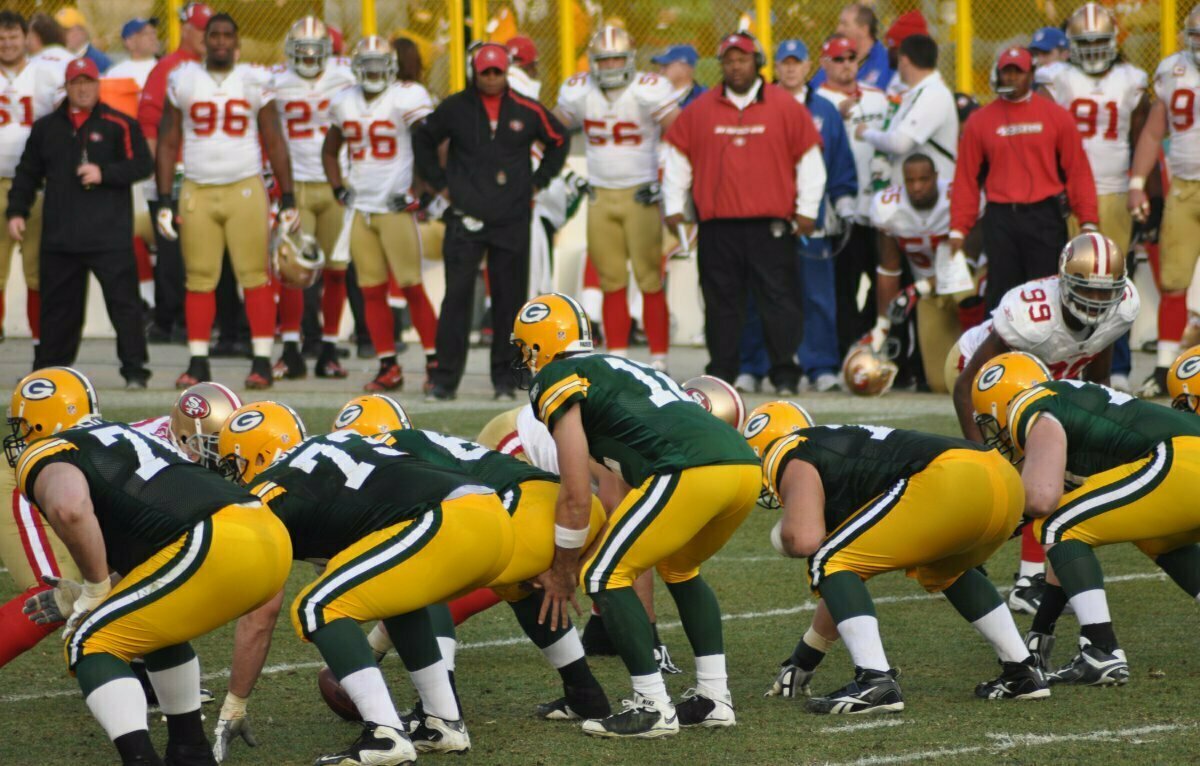
American Football (NFL & College ) is played 11 aside and the following is a quick guide to the skill positions on the offensive side of the ball.
Offensive Line
The positioning and options available to the players on the of the offence side of the ball are governed by a strict set of rules and generally speaking, the team is split into two groups “Blockers” who protect the Quarter Back and make space for the runners and the passers/runners and backs & receivers who are responsible for advancing the ball. The offensive line is the “Blockers” and normally numbers five. Split a follows:
Center (C)
Fairly self-explanatory – the Center is the player who generally starts off in the middle of the line and is the one who begins the play by snapping the ball to the quarterback. In keeping with the other offensive linemen, the center’s job once the ball is snapped is to block defensive players. He also often responsible for organising the other blockers assignments (who is blocking who) and making last-second adjustments depending on the defensive look he sees i.e the defense may suddenly bring an extra rusher in.
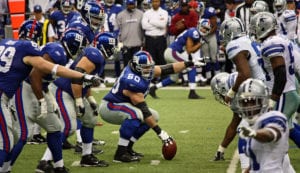
The Center set to snap the ball Ken Durden / Shutterstock.com
Offensive Guard (OG)
There are two guards, left and right and they flank the center. They are often known as interior linemen, and they block on both running and passing plays. On some passing plays they will form a pocket around the QB giving him time to get the pass off, while on others some plays, they will move out of the starting position to protect the QB if he is either forced out of the pocket (flushed) or decides to roll out of the pocket on a predetermined play such as a screen. They may also do this when lead blocking for the ball carrier. They (along with any of the offensive linemen) are not allowed to handle the ball unless it is fumbled, or a pass is deflected. They are also prohibited from holding onto an opponent and from blocking a defender in the back if they get past them.
Offensive Tackle (OT)
The remainder of the line is formed by a right and left tackle who flank the two Guards. Their primary role is to block the edge rushers and protect the Quarterbacks Blind Side. This position is the only one on the field which can block an opponent in the back, although this is only allowed within the area from one tackle to the other. Which hand the QB uses to throw will determine his blind side with a right-handed quarterback, depending on the left tackle to protect him from being hit from behind. Given this, the relevant OT is one of the most skilled and highly regarded players on the team – although they rarely get the media attention they deserve.
Receivers & Backs
There are five more players on the team in this category, although all kinds of permutations are possible. This is a typical formation.
Wide Receiver (WR)
Wide receivers are the teams’ pass-catchers although they do occasionally take on blocking roles. Their main role is to get downfield and catch passes thrown to them. There is normally one on each side of the field and a player will normally specialise in playing left sided or right side. The name comes from the fact that they tend to line up near the sidelines hence wide of the main area of play. Depending on the formation of the play one or more may line up on the line of Scrimmage to ensure that the required seven players are on it (yes the rules are very prescribed), although more typically the Tight Ends will make up the front seven. One other term often heard is the slot receiver and this is where a receiver lines up inside of another receiver i.e closer to the offensive line. One will also typically start behind the line of scrimmage and he is known as the Flanker. Wide receiver is one of the more notable positions given they do most of the scoring and are involved in exciting plays.
Tight End (TE)
Tight ends are something of a hybrid, often called on to assist in blocking duties like an OT and sometimes being used like Wide Receivers in a pass-catching role. On a typical formation, two Tight Ends will line up directly next to, the Offensive Tackles one on each side. Their blocking duties are normally reserved for designated running plays but they may be called in especially on running plays. However, because they are eligible receivers, they may also catch passes. The TE position is not compulsory and when a spread play is called they are replaced with Wide Receivers – sometimes referred to as a 4 wide set. They are also occasionally used in the halfback position )H-back) where they line up behind the line of scrimmage as one of the four “backs”. This position is more often taken by a running back though.
Running Back (RB)
Running Back is one of the most versatile roles on the field, and although they typically make most of their plays from having the ball handed off to them by the quarterback and running forward with it, they are often required to catch passes out of the backfield and to assume blocking roles on designated passing plays. There is normally at least one running back on the field at any one time, however, often two are employed (with one used to lead a path for the ball carrier, and occasionally none will be used (known as an empty backfield). Running backs are sometimes used on special teams also as punt and kickoff returners.
Quarterback (QB)
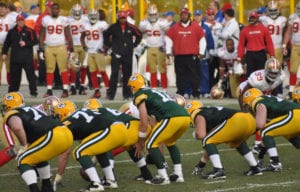
Green Bay QB Aaron Rodgers waiting to receive the snap from the Center
Mark Herreid / Shutterstock.com
Last but by no means least we have the Quarterback. This is the most important position on the field and the QB is regarded as the captain or leader of the team. His main responsibility is to get the ball into the hands of the Receivers or running backs, although they are eligible to advance the ball themselves too. The Quarterback receives the play calls from the coaches on the sidelines and communicates the plays to the other offensive players, usually in what is known as the huddle. They may also make changes to the play at the line of scrimmage (known as an “audible”), depending on the defensive formation. Once they have received the ball (the snap), the quarterback has three basic options to advance the ball. They can run with it, hand it to another eligible ball carrier to run with, or make a pass to another player. They always start from behind the line of scrimmage, and this is typically known as “under center” when they are in close proximity to the Center ready to receive the ball(as in the picture above). They can also line up a few feet behind the centre some distance behind the center and this is known as the “shotgun formation”. The Quarterback tends to be the highest paid player onthe field and getting what is known as a franchise QB (a high calibre starter) is not easy.
